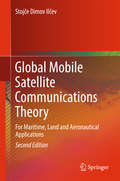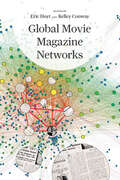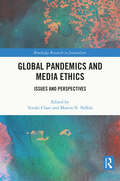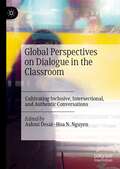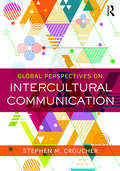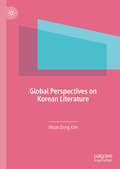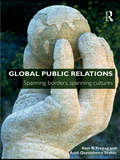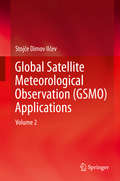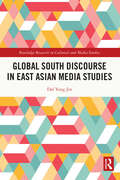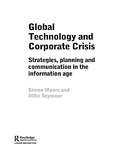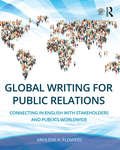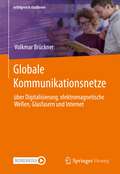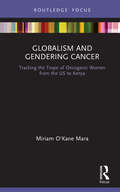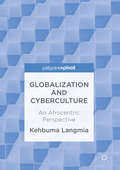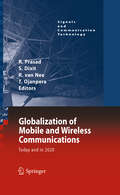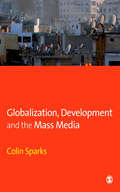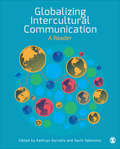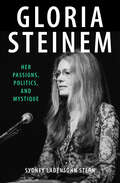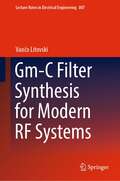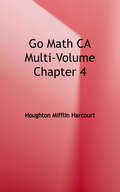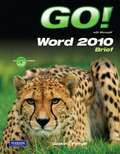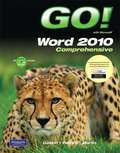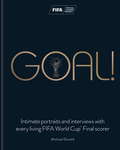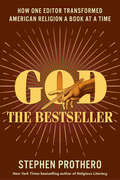- Table View
- List View
Global Mobile Satellite Communications Theory
by Stojče Dimov IlčevThis book discusses current theory regarding global mobile satellite communications (GMSC) for maritime, land (road and rail), and aeronautical applications. It covers how these can enable connections between moving objects such as ships, road and rail vehicles and aircrafts on one hand, and ground telecommunications subscribers through the medium of communications satellites, ground earth stations, Terrestrial Telecommunication Networks (TTN), Internet Service Providers (ISP) and other wireless and landline telecommunications providers. The new edition covers new developments and initiatives that have resulted in land and aeronautical applications and the introduction of new satellite constellations in non-geostationary orbits and projects of new hybrid satellite constellations. The book presents current GMSC trends, mobile system concepts and network architecture using a simple mode of style with understandable technical information, characteristics, graphics, illustrations and mathematics equations. The first edition of Global Mobile Satellite Communications (Springer, 2005) was split into two books for the second edition - one on applications and one on theory. This book presents global mobile satellite communications theory.
Global Movie Magazine Networks
by Eric Hoyt and Kelley ConwayA free ebook version of this title is available through Luminos, University of California Press’s Open Access publishing program. Visit www.luminosoa.org to learn more. This groundbreaking collection of essays from leading film historians features original research on movie magazines published in China, France, Germany, India, Iran, Latin America, South Korea, the U.S., and beyond. Vital resources for the study of film history and culture, movie magazines are frequently cited as sources, but rarely centered as objects of study. Global Movie Magazine Networks does precisely that, revealing the hybridity, heterogeneity, and connectivity of movie magazines and the important role they play in the intercontinental exchange of information and ideas about cinema. Uniquely, the contributors in this book have developed their critical analysis alongside the collaborative work of building digital resources, facilitating the digitization of more than a dozen of these historic magazines on an open-access basis.
Global Pandemics and Media Ethics: Issues and Perspectives (Routledge Research in Journalism)
by Tendai Chari Martin N. NdlelaThis topical volume illuminates ethical issues brought to the fore by the COVID-19 pandemic. Drawing on a broad range of case studies from different regions, it provides insights into the multiple and complex ways in which the pandemic has shaped media ethics. The chapters employ a wide range of innovative theoretical and methodological approaches to dissect enduring and emerging ethical questions during the pandemic, providing lucid accounts of axiological dimensions in pandemic discourses, ethics of emotional mood, ethical challenges and dilemmas in news reporting, propaganda, misinformation, disinformation and Othering. While the case studies in this book are unique, the authors have extrapolated common strands from their analysis of ethical issues applicable to any other country or region during the pandemic, contributing unique perspectives on how media ethics are circumscribed by global health pandemics. The book will appeal to researchers, academics and practitioners at all levels in the fields of media studies, journalism, communication, media sociology and public health, as well as general readers and policymakers who are keen to learn more about how global health crises illuminate critical ethical issues confronting the media.
Global Perspectives on Dialogue in the Classroom: Cultivating Inclusive, Intersectional, and Authentic Conversations
by Ashmi Desai Hoa N. NguyenThis book explores globally-informed, culturally-rooted approaches to dialogue in the classroom. It seeks to fill gaps in communication and education literature related to decolonizing dialogue and breaking binaries by decentering Eurocentric perspectives and providing space for dialogic practices grounded in cultural wealth of students and teachers. We first describe the book’s genesis, contextualize dialogue within the global impact of the COVID-19 pandemic, and share guiding concepts of inclusion, intersectionality, and authenticity in dialogue and pedagogy. We also distinguish dialogue from other practices and times in which dialogue may not be possible. The book brings fresh and urgent perspectives from authors across different disciplines, including ceramics, religious studies, cultural studies, communication, family therapy, and conflict resolution. The chapters distill the idea of dialogue within contexts like a bible circle, university sculpture studio, trauma and peacebuilding program, and connect dialogue to teaching, learning, and emerging ideas of power disruption, in-betweenness, and relationality.
Global Perspectives on Intercultural Communication
by Stephen M. CroucherWhat is intercultural communication? How does perspective shape a person’s definition of the key tenets of the term and the field? These are the core questions explored by this accessible global introduction to intercultural communication. Each chapter explores the topic from a different geographic, religious, theoretical, and/or methodological perspective, with an emphasis on non-Western approaches, including Buddhist, South American, Muslim, and Chinese perspectives. Featuring the voices of a range of international contributors, this new textbook presents the full breadth of diverse approaches to intercultural communication and showcases the economic, political, and cultural/societal needs for and benefits of communicative competence.
Global Perspectives on Korean Literature
by Wook-Dong KimThis book explores Korean literature from a broadly global perspective from the mid-9th century to the present, with special emphasis on how it has been influenced by, as well as it has influenced, literatures of other nations. Beginning with the Korean version of the King Midas and his ass’s ears tale in the Silla dynasty, it moves on to discuss Ewa, what might be called the first missionary novel about Korea written by a Western missionary W. Arthur Noble. The book also considers the extent to which in writing fiction and essays Jack London gained grist for his writing from his experience in Korea as a Russo-Japanese War correspondent. In addition, the book explores how modern Korean poetry, fiction, and drama, despite differences in time and space, have actively engaged with Western counterparts. Based on World Literature, which has gained slow but prominent popularity all over the world, this book argues that Korean literature deserves to be part of the Commonwealth of Letters.
Global Public Relations: Spanning Borders, Spanning Cultures
by Alan R. Freitag Ashli Quesinberry StokesThis text provides a structured and practical framework for understanding the complexities of contemporary public relations. It is an instructional book that guides the reader through the challenges of communication and problem solving across a range of organizations and cross-cultural settings. Written in a straightforward, lively style, the book covers: foundational theories, and factors that shape the discipline communication across cultures trends affecting the public relations profession throughout the world. Incorporating case studies and commentary to illustrate key principles and stimulate discussion, this book also highlights the different approaches professionals must consider in different contexts, from communicating with employees to liaising with external bodies, such as government agencies or the media. Offering a truly global perspective on the subject, Global Public Relations is essential reading for any student or practitioner interested in public relations excellence in a global setting. A companion website provides additional material for lecturers and students alike: www.routledge.com/textbooks/9780415448154/
Global Satellite Meteorological Observation (GSMO) Applications: Volume 2
by Stojče Dimov IlčevThis book presents principal structures of space systems functionality of meteorological networks, media and applications for modern remote sensing, transmission systems, meteorological ground and users segments and transferring weather data from satellite to the ground infrastructures and users. The author presents techniques and different modes of satellite image interpretation, type of satellite imagery, spectral imaging properties, and enhancement of imaging technique, geo-location and calibration, atmospheric and surface phenomena. Several satellite meteorological applications are introduced including common satellite remote sensing applications, weather analysis, warnings and prediction, observation and measurements of meteorological variables, atmosphere and surface applications, ocean and coastal applications, land, agriculture and forestry applications, and maritime and aviation satellite weather applications. The author also covers ground segment and user segment in detail. The final chapter looks to the future, covering possible space integrations in meteorological and weather observation.This is a companion book of Global Satellite Meteorological Observation Theory (Springer), which provides the following topics:Evolution of meteorological observations and history satellite meteorologySpace segment with satellite orbits and meteorological payloadsAnalog and digital transmission, type of modulations and broadcasting systemsAtmospheric radiation, satellite meteorological parameters and instrumentsMeteorological antenna systems and propagation
Global South Discourse in East Asian Media Studies (Routledge Research in Cultural and Media Studies)
by Dal Yong JinThis book examines the nexus of East Asian media, culture, and digital technologies in the early 21st century from a Global South perspective. Providing an empirically rich analysis of the emergence of Asian culture, histories, texts, and state policies as they relate to both Asian media and global media, the author discusses relevant theoretical frameworks as East Asian popular culture and media have shifted the contours of globalization. After overviewing Western media/cultural theories and histories, the book explores the ways in which East Asia-focused analytical frameworks are able to shift people’s understanding of globalization and media, drawing upon examples from different East Asian countries to illustrate how current cultural flows have influenced and have been influenced by a handful of dimensions. Offering an important contribution to understanding the historical trajectory and recent developments of East Asia media, this book will interest students and scholars of media, communication, popular culture, cultural studies, Asian studies, politics and sociology.
Global Technology and Corporate Crisis: Strategies, Planning and Communication in the Information Age
by Simon Moore Mike SeymourAccelerating global change is generating a volatile, shifting and potent array of risks and threats for business and corporate management. If business is to survive and recover, the authors argue that a major shift is needed that embraces corporate culture, operational planning and the key role of communication in the information revolution. This innovative text meets this challenge head on. It includes informed insights into the implications for strategic planning, management and communications handling for companies facing serious issues and crisis situations in tomorrow’s corporate world. With a wide-ranging review of the information and communications revolution, and a forecast of future parameters for planning and execution of crisis management, this book will be invaluable reading for all those involved in the strategic management of technology and corporate communications.
Global Writing for Public Relations: Connecting in English with Stakeholders and Publics Worldwide
by Arhlene A. FlowersGlobal Writing for Public Relations: Connecting in English with Stakeholders and Publics Worldwide provides multiple resources to help students and public relations practitioners learn best practices for writing in English to communicate and connect with a global marketplace. Author Arhlene Flowers has created a new approach on writing for public relations by combining intercultural communication, international public relations, and effective public relations writing techniques. Global Writing for Public Relations offers the following features: Insight into the evolution of English-language communication in business and public relations, as well as theoretical and political debates on global English and globalization; An understanding of both a global thematic and customized local approach in creating public relations campaigns and written materials; Strategic questions to help writers develop critical thinking skills and understand how to create meaningful communications materials for specific audiences; Storytelling skills that help writers craft compelling content; Real-world global examples from diverse industries that illustrate creative solutions; Step-by-step guidance on writing public relations materials with easy-to-follow templates to reach traditional and online media, consumers, and businesses; Self-evaluation and creative thinking exercises to improve cultural literacy, grammar, punctuation, and editing skills for enhanced clarity; and Supplemental online resources for educators and students. English is the go-to business language across the world, and this book combines the author's experience training students and seasoned professionals in crafting public relations materials that resonate with global English-language audiences. It will help public relations students and practitioners become proficient and sophisticated writers with the ability to connect with diverse audiences worldwide.
Globale Kommunikationsnetze: über Digitalisierung, elektromagnetische Wellen, Glasfasern und Internet (erfolgreich studieren)
by Volkmar BrücknerAufbauend auf gymnasialen Kenntnissen werden die Zusammenhänge zwischen Glasfaser-Festnetz als Grundlage für schnelle Datenübertragung und mobilen Geräten wie Smartphones als Zugang zu Informationen immer und von überall geschildert. Dabei werden vorrangig Methoden der digitalen Informationsübertragung behandelt. Besonderer Wert wird anhand von Beispielen auf die Entwicklung von Fähigkeiten gelegt, technische Probleme in eine „Ingenieurssprache“ zu übertragen. Zudem werden Probleme der Datensicherheit und deren mögliche Lösungen in der Zukunft an Beispielen erläutert.
Globalism and Gendering Cancer: Tracking the Trope of Oncogenic Women from the US to Kenya (Routledge Focus on Communication Studies)
by Miriam O'Kane MaraThis book connects a rhetorical examination of medical and public health policy documents with a humanistic investigation of cultural texts to uncover the link between gendered representations of health and cancer. The author argues that in western biomedical contexts cancer is considered a women’s disease and their bodies are treated as inherently oncogenic or cancer-producing, which leads to biomedical practices that adversely impact their bodily autonomy. She examines how these biases traverse national boundaries by examining the transmission of biomedical cancer practices from the US and international organizations to Kenya. This book is suited to scholars and students working in the fields of Rhetorics of Health and Medicine, Medical Humanities and Gender Studies. It is also of interest to medical professionals and readers interested in globalism and global health.
Globalization and Cyberculture
by Kehbuma LangmiaThis book argues for hybridity of Western and African cultures within cybercultural and subcultural forms of communication. Kehbuma Langmia argues that when both Western and African cultures merge together through new forms of digital communication, marginalized populations in Africa are able to embrace communication, which could help in the socio-cultural and political development of the continent. On the other hand, the book also engages Richard McPhail's Electronic Colonization Theory in order to demonstrate how developing areas such as Africa experience a new form of imperialistic subjugation because of electronic and digital communication. Globalization and Cyberculture illustrates how new forms of communication inculcate age-old traditional forms of communications into Africa's cyberculture while complicating notions of identity, dependency, and the digital divide gap.
Globalization of Mobile and Wireless Communications
by Sudhir Dixit Ramjee Prasad Tero Ojanpera Richard Van NeeGlobalization of Mobile and Wireless Communications is a collection of cutting-edge research in mobile and wireless communications with impact on developments as far forward as 2020 and beyond. The book draws upon the insights and performed research work of leading experts in the field. Topics of discussion are related but not limited to spectrum-efficient radio interface technologies, enabling technologies for reconfigurability, wireless sensor networks, cognitive networks, coherent wireless transmission, algorithmic design, middleware for novel services and applications. The material has been edited to provide a vision for the future of mobile and wireless, towards a dynamic communication system that breaks down the barriers between communications means; and evolves and integrates business models and culture to match the technological evolution. In addition, strategies on how to overcome the technological challenges for achieving that vision are also outlined.
Globalization, Development and the Mass Media (Media Culture And Society Ser.)
by Colin SparksGlobalization, Development and the Mass Media gives a comprehensive and critical account of the theoretical changes in communication studies from the early theories of development communication through to the contemporary critiques of globalization. It examines two main currents of thought. Firstly, the ways in which the media can be used to effect change and development. It traces the evolution of thinking from attempts to spread ′modernity′ by way of using the media through to alternative perspectives based on encouraging participation in development communication. Secondly, the elaboration of the theory of media imperialism, the criticisms that it provoked and its replacement as the dominant theory of international communication by globalization.
Globalizing Intercultural Communication: A Reader
by Kathryn Sorrells Sachi SekimotoTranslating Theory into Practice Globalizing Intercultural Communication: A Reader introduces students to intercultural communication within the global context, and equips them with the knowledge and understanding to grapple with the dynamic, interconnected and complex nature of intercultural relations in the world today. This reader is organized around foundational and contemporary themes of intercultural communication. Each of the 14 chapters pairs an original research article explicating key topics, theories, or concepts with a first-person narrative that brings the chapter content alive and invites students to develop and apply their knowledge of intercultural communication. Each chapter’s pair of readings is framed by an introduction highlighting important issues presented in the readings that are relevant to the study and practice of intercultural communication and end-of-chapter pedagogical features including key terms and discussion questions. In addition to illuminating concepts, theories, and issues, authors/editors Kathryn Sorrells and Sachi Sekimoto focus particular attention on grounding theory in everyday experience and translating theory into practice and actions that can be taken to promote social responsibility and social justice.
Globalizing Intercultural Communication: A Reader
by Kathryn Sorrells Sachi SekimotoTranslating Theory into Practice Globalizing Intercultural Communication: A Reader introduces students to intercultural communication within the global context, and equips them with the knowledge and understanding to grapple with the dynamic, interconnected and complex nature of intercultural relations in the world today. This reader is organized around foundational and contemporary themes of intercultural communication. Each of the 14 chapters pairs an original research article explicating key topics, theories, or concepts with a first-person narrative that brings the chapter content alive and invites students to develop and apply their knowledge of intercultural communication. Each chapter’s pair of readings is framed by an introduction highlighting important issues presented in the readings that are relevant to the study and practice of intercultural communication and end-of-chapter pedagogical features including key terms and discussion questions. In addition to illuminating concepts, theories, and issues, authors/editors Kathryn Sorrells and Sachi Sekimoto focus particular attention on grounding theory in everyday experience and translating theory into practice and actions that can be taken to promote social responsibility and social justice.
Gloria Steinem: Her Passions, Politics, and Mystique
by Sydney Ladensohn SternIncludes a new afterword: A &“richly detailed&” biography of the iconic feminist based on interviews with friends, family, colleagues, and Steinem herself (The Washington Post). Going beyond Gloria Steinem&’s public persona, this biography provides an in-depth portrait of the famed activist—covering her family of origin, Smith College education, travels in India, founding of Ms. magazine, and much more—drawn from fifty hours of interviews with Steinem, as well as conversations with more than two hundred people in her life. &“Stern&’s biography is sympathetic but critical about the woman who was once perhaps the foremost figure of American feminism. . . . Follows its subject from her childhood with a mentally ill mother and ne&’er-do-well father through her rise in the women&’s movement.&” —The New York Times Book Review &“Feminist icon, goddess, social climber, bunny—who is Gloria Steinem? All of the above, according to [this] serious new biography. . . . A real look at Steinem off the public platform.&” —Kirkus Reviews &“Avoiding esoteric psychological or feminist theorizing, Stern still provides a clear context for Steinem&’s development both as a public figure and as an exemplar of the movement that seeks to have women define themselves as autonomous individuals.&” —Library JournalIncludes photographs
Gm-C Filter Synthesis for Modern RF Systems (Lecture Notes in Electrical Engineering #807)
by Vančo LitovskiThis book discusses synthesis of Gm-C filter for modern radio frequency systems. Analogue filters are an inevitable part of the chain of signal processing in modern radio and telecommunication systems. Among the technologies implemented for these purposes are the so-called Gm-C filters which are built of operational transconductance amplifiers and capacitors. This technology allows for integration of the filter into a CMOS system-on-chip so making it very attractive for application in low-power (battery operated) devices. The objective of this book is to achieve three goals: (1) to fully describe the circuit synthesis procedures for parallel, cascade, and a realization based on LC prototypes; (2) to make a thorough evaluation of the advantages and disadvantages of these methods and to recommend the “preferable” one; and (3) to create an extensive table of element values of cascaded Gm-C filters realizing the best-known low-pass filter functions. The book will influence the design community to embrace this technology even for non-communication applications.
Go Math CA Multi-Volume Chapter 4
by Houghton Mifflin HarcourtCalifornia Go Math! Chapter 4 Divide by 1-Digit Numbers In this chapter, you will explore and discover answers to the following Essential Questions: - How can you divide by 1-digit numbers? - How can you use remainders in division problems? - How can you estimate quotients? - How can you model division with a 1-digit divisor?
Go! With Microsoft Word 2010 (Brief Edition)
by Shelley Gaskin Robert L. FerrettFor introductory computer courses on Microsoft Word 2010 or courses in computer concepts with a lab component on Word. Teach the course YOU want in LESS TIME! The primary goal of the GO! Series, aside from teaching computer applications, is ease of implementation. This approach is based on clearly defined projects for students and a one-of-a-kind supplements package for instructors.
Go! With Microsoft Word 2010, Comprehensive
by Shelley Gaskin Robert L. Ferrett Carol L. Martin<P>In today's fast-moving, mobile environment, the GO! with Office 2016 series focuses on the job skills needed to succeed in the workforce.<P> With job-related projects that put Microsoft Office® into context, students learn the how and why at the moment they need to know, all in the appropriate Microsoft procedural syntax.<P> For Office 2016, the hallmark guided-practice to skill-mastery pathway is better than ever. <P>Students have many opportunities to work live in Microsoft office to apply the skills they've learned.<P> In addition, instructional projects are now available as grader projects in MyITLab, so students can work live in Office while receiving auto-graded feedback.<P> These high-fidelity simulations match the text and provide an effective pathway for learning, practicing, and assessing their abilities. After completing the instructional projects, students can apply their skills with a variety of progressively challenging projects that require them to solve problems, think critically, and create on their own. <P>New GO! Collaborate with Google projects allow students to apply their skills to a new environment that is already popular in many workplaces.<P> Integrated Microsoft Office Specialist (MOS) objectives make GO! your one resource for learning Office, gaining critical productivity skills, and prepare for MOS certification.
Goal!: Intimate portraits and interviews with every living FIFA World Cup Final scorer
by Michael DonaldBeautifully illustrated and officially licensed by FIFA, Goal! is a unique football book that captures the essence of the ultimate sporting achievement.This is a fascinating portrait of the men who have lived the dream of every football fan worldwide. Includes: Intimate portraits by award-winning photographer Michael DonaldInterviews with the players, giving fascinating insight into the occassion, from the music they played on the bus to the stadium, to the meal they ate afterwardsProfiles on Pelé, Ronaldo, Zidane, Götze annd many more of the greatsThe book includes the story of what happened in each FIFA World Cup?, what happened to the players afterwards and what they do today. There's also a comprehensive statistics section covering all the facts and figures for each World Cup tournament so readers can relive the matches they saw, and discover the details about the ones they didn't.
God the Bestseller: How One Editor Transformed American Religion a Book at a Time
by Stephen ProtheroNew York Times bestselling author and acclaimed religion scholar, Stephen Prothero, captures the compelling and unique saga of twentieth-century America on an identity quest through the eyes and books of one of the most influential editors of the day—a search, born of two world wars, for resolution of our divided identity as a Christian nation and a nation of religions.One summer evening in 1916 in Blanchester, Ohio, a sixteen-year-old farm boy was riding his horse past the town cemetery. The horse reared back and whinnied, and Eugene Exman saw God. For the rest of his life, he struggled to recreate that moment. Through a treasure of personal letters and papers, God, the Bestseller explores Exman’s personal quest. A journey that would lead him in the late 1920s to the Harper religious books department, which he turned during the Great Depression into a money-making juggernaut and the country’s top religion publisher. Exman’s role in the shaping of American religion is undeniable. Here was a man who was ahead of his time and leading the rest of the nation through books on a spiritual exploration. Exman published bestsellers by the controversial preacher Harry Emerson Fosdick, the Catholic radical Dorothy Day, the Civil Rights pioneer Howard Thurman, and two Nobel laureates: Albert Schweitzer and Martin Luther King Jr. Exman did not just sit at a desk and read. In addition to his lifelong relationships with the most influential leaders of the day, Exman was on a spiritual journey of his own traversing the world in search of God. He founded a club of mystics, dropped acid in 1958, four years before Timothy Leary. And six years before The Beatles went to India, he found a guru there in 1962. In the end, this is the story of the popularization of the religion of experience—a cultural story of modern America on a quest of its own. Exman helped to reimagine and remake American religion, turning the United States into a place where denominational boundaries are blurred, diversity is valued, and the only creed is that individual spiritual experience is the essence of religion.
